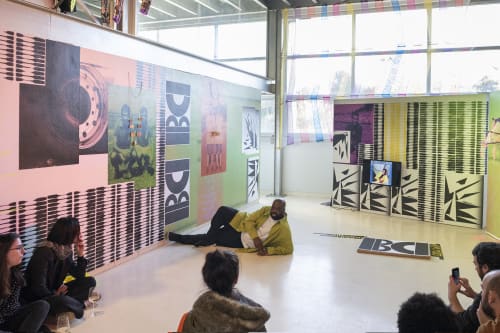Coalescence (Coalescences, Coalitions, Collisions, Collapses) is an example of an organic curatorial project that arises at a certain moment and evolves over time and changes to continue to exist and to dialogue with the moment. Its creator, Paul O’Neill, is a touchstone in thinking about curatorial practice far from conceptual theorizing. His reflections are born out of curiosity and from interviews with curators and artists that he considers important. His work is based on collaboration with artists by generating a complicity that implies encounters, resignations, frictions and discoveries, as well.
Which is why the exhibition text being presented on adnplatform is not the typical theoretical text for exhibition curation but rather a conversation between the two curators: Paul O’Neill and Xavier Acarín. Xavier accompanies Paul in the instant (but not the itinerary) of the Coalescence exhibition, contributing with the inclusion of artists who perhaps were not on O’Neill’s radar but who contribute to enriching a project that demystifies curatorial work while becoming a practical attempt, a statement or a declaration of principles. In this sense, the exhibition that can be seen on Adn Platform until May 20, 2023 is the tip of an iceberg for which it is crucial to dive deep to appreciate.
What is the history of Coalescence (Coalescences, Coalitions, Collisions, Collapses)? Coalescence began in 2003 at the London Print Studio where Paul O’Neill worked as a curator. O’Neill took advantage of the studio’s print workshop to work in collaboration with Jaime Gili, Kathrin Böhm and Eduardo Padilha, who made a series of images to cover the space, thus breaking down the distinctions between spaces of production and spaces of exhibition. As O’Neill recalls in the conversation with Xavier Acarín, the impact of Nicolas Bourriaud’s “relational aesthetics” was still in the air, echoing artistic practices in which meetings and participation generated situational installations that developed over a specific time. It is no accident that relational aesthetics found clear precedents in certain curatorial practices of the 1960s, with references such as Seth Siegelaub, with whom O’Neill had in-depth interviews. This was the moment of “performative curating” in which artistic and curatorial practices were absolutely permeable. A paradigmatic example: the curating of Utopia Station by Hans-Ulrich Obrist, Rirkrit Tiravanija and Molly Nesbit at the Arsenale in the Venice Biennale (2003), which perfected the idea of accumulation and uncertainty.
The exhibition at the London Print Studio in 2004 was followed by other “itineraries” (in the least institutional sense one can imagine) in Redux (London), Palma Dotze (Vilafranca del Penedés, 2004), Model and Niland Art Gallery, (Sligo, Ireland, 2004) and SMART project space (Amsterdam, 2009), until arriving at this version of the exhibition. Between the first experience and the most recent there have been a variety of formats and collaborations: film screenings, associate curators, poker sessions, public and private dialogues and, in total, almost a hundred artists involved.
Coalescence is also an active reflection (by doing) on exhibitions, on the institution as a space for activity, on real and vital processes that are as important as the final result, on the exhibition as a “testing ground” —as Acarín writes— and on performativity as a tool to escape from neoliberal premises. The art work shown on adnplatform —which coexist in the space created by Kathrin Böm, Jaime Gili and Eduardo Padilha— question the tired old compartmentalization of knowledge (Suzanne Mooney), the corporate control over corporal contact (Pilvi Takala), the institutional and official interpretation of the nature of art work in a museum (Núria Güell), and stereotypes of gender and race (Harold Offeh).
Coalescence is, in short, a space of uncertainty, collaboration, friction and freedom, both critical and festive at the same time; and the inauguration on Saturday November 26, on Adn Platform, was a good example of celebrating reunions and sharing talk and laughter.



